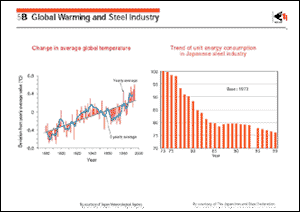Controlling the emissions of carbon
dioxide (CO2) as a measure against
global warming is one of the crucial environmental issues that
the steel industry must undertake.
As shown on the left side of the figure, the average temperature
of the earth began to rise in the latter half of the 1970s, and
this trend became more pronounced in the 1980s. Global warming
is considered to be due to an increase in the concentration of
greenhouse-effect gases, including CO2,
in the atmosphere. The present CO2
concentration in the atmosphere is about 340 ppm and is increasing
annually by about 1.5 ppm. The main cause of this increase in
CO2 concentration is believed to be
the increasing combustion of carbon in fossil fuels from the
1950s onward. According to a joint research prediction by the
United Nations and the World Meteorological Organization, if
the emission of greenhouse-effect gases by human activities continues
without any preventive measures, the average global temperature
will be 3 degrees higher in the early 22nd century than at present.
The energy we use at present depends on fossil fuel to a great
extent. To control the emission of CO2,
therefore, it is necessary to seek alternative energy sources
and to use energy more efficiently. The shift to new energy sources
and the technology to fix CO2 are
mostly in the development stage, and considerable time will be
needed to put these measures into practical use. Accordingly,the
focus today must be on the effective use of energy, i.e., energy
saving, and the steel industry is no exception to this principle.
As shown in the figure, the Japanese steel industry cut its unit
energy consumption by about 20% from 1973 to 1986. During this
period, the Japanese steel industry made equipment investments
of  1.4 trillion for environmental measures and 1.4 trillion for environmental measures and  1.3 trillion for energy saving measures. 1.3 trillion for energy saving measures. |
|
 |
 |
 |
|
|